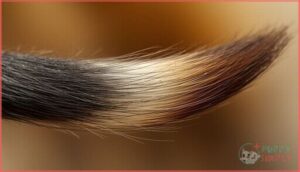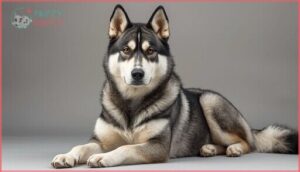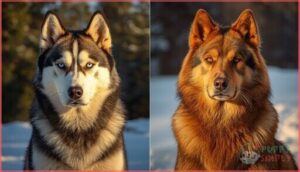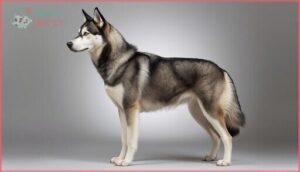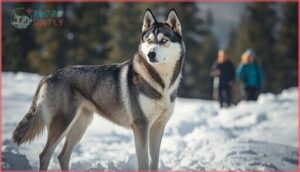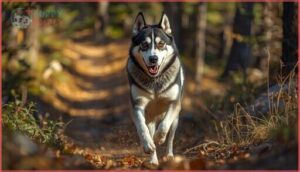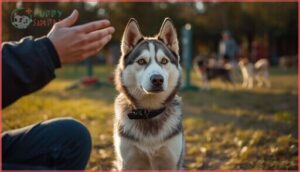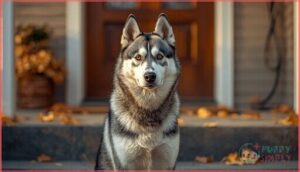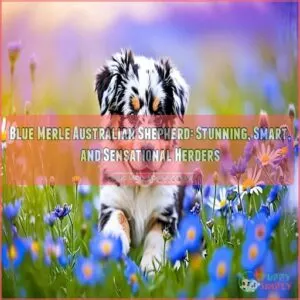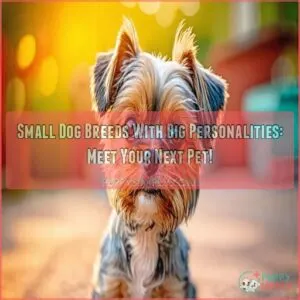This site is supported by our readers. We may earn a commission, at no cost to you, if you purchase through links.
Peer into the gaze of an agouti husky and you’re staring at a coat patterned by evolution—a wild tapestry of banded hairs, where earthy grays, smudged tans, and dramatic blacks blend like the brushstrokes of a northern landscape. Unlike their show-ring cousins, these huskies wear colors straight from their working roots, a genetic calling card that whispers of wolves and wide-open spaces.
Their agouti pattern isn’t just color; it’s a visible chapter in the breed’s natural history, unfolding across every strand. Understanding what sets agouti huskies apart opens the door to a world where genetics, appearance, and lively temperament collide.
Table Of Contents
- Key Takeaways
- What is an Agouti Husky?
- Agouti Husky Coat Appearance
- Genetics Behind The Agouti Coat
- Physical Characteristics and Size
- Temperament and Personality Traits
- Exercise and Activity Needs
- Grooming and Coat Care
- Health and Lifespan Considerations
- Training and Socialization Tips
- Finding and Owning an Agouti Husky
- Frequently Asked Questions (FAQs)
- Conclusion
Key Takeaways
- Agouti huskies display a wild-type coat pattern where each hair shows alternating black and tan bands, creating a wolf-like appearance that’s genetically controlled by the agouti gene and its variants at the A-Locus.
- These dogs require 1-2 hours of vigorous daily exercise and significant mental stimulation through puzzle toys and varied activities, making them unsuitable for sedentary owners or typical apartment living.
- Despite their striking appearance, agouti huskies are purebred Siberian Huskies with the same temperament as other color variants—highly intelligent, independent, social, and vocal—requiring consistent training with positive reinforcement to manage their stubborn streak.
- Responsible ownership involves understanding their moderate health concerns (eye conditions affecting 12-15%, hip dysplasia up to 20%), maintaining their double coat through regular brushing during heavy seasonal shedding, and ensuring proper socialization from puppyhood to support their naturally friendly disposition.
What is an Agouti Husky?
An Agouti Husky is basically a Siberian Husky sporting one of nature’s most clever disguises—a wild, wolf-like coat that’s been part of the breed standard all along. This unique coloring comes from a special pattern where each hair shows bands of light and dark pigment, creating that distinctive wilderness look you might recognize from their ancient ancestors.
Understanding what sets these dogs apart starts with knowing their definition, recognizing their standout coat features, and seeing how they differ from the Huskies you’re probably more familiar with.
Definition of Agouti Husky
An Agouti Husky is a purebred Siberian Husky displaying wildtype coloring, a distinctive pattern often called wolf sable. This coat coloration stems from a specific genetic basis where individual hairs show alternating black and tan bands, creating that wolf-like appearance you might recognize.
Despite their wild look, these dogs aren’t wolf hybrids:
- They’re recognized within the breed standard for Siberian Huskies
- The agouti coat results from the wild-type allele at the agouti gene
- Each hair features banded pigmentation switching between black and red tones
- They maintain the same size and structure as other Husky colors
Agouti Huskies are common in working and sled dog lines.
Key Features of Agouti Coat
When you look closely at an agouti coat, you’ll notice each individual hair features alternating black and tan bands—that’s the hallmark of banded coloration. These markings generally concentrate on the back, legs, and head, while cream or off-white tones appear on the chest and belly. The distinctive “goggles” around the eyes instantly set this rare, wolf-like pattern apart. This pattern is determined by the A-Locus genetics.
Differences From Standard Huskies
While standard huskies flaunt crisp black-and-white or red-and-white facial markings, your agouti husky displays a darker, less defined mask due to those banded hairs. The agouti coat creates a wild, wolf-like appearance that’s considerably rarer than typical husky breed colors.
You’ll also notice temperament traits mirror standard huskies—energetic, independent, vocal—but purchase prices often run higher, usually $1,000 to $3,000, reflecting these rarity factors.
Agouti Husky Coat Appearance
The agouti coat isn’t just a single solid color—it’s actually a complex pattern that comes from how pigment distributes along each individual hair. This creates a wild, wolf-like appearance that sets these Huskies apart from their more commonly seen counterparts.
Let’s break down exactly what makes this coat so distinctive, from the banded hairs themselves to the telltale markings you’ll spot on an agouti Husky.
Banded Hair Coloration Explained
Think of each hair on your agouti Husky as a tiny striped barber pole. Pigment banding creates this multi-colored effect through genetic control of two pigments: eumelanin (black/brown) and phaeomelanin (red/yellow).
Here’s how banded hairs work:
- Each hair alternates between dark and light bands during growth
- The tip is usually darkest, containing concentrated eumelanin
- Color variations depend on band width and distribution
- This mammalian comparison mirrors wolves’ natural camouflage purpose
- Coat color genetics drive these shifts in pigment production
Common Markings and Patterns
When you examine your agouti Husky’s coat pattern closely, you’ll notice signature markings that set these dogs apart. Over 80% display a heavy facial mask covering the muzzle and eyes, while 65% sport tan spectacle markings around their eyes.
You’ll find black pencilling on the toes in about half of all agouti Huskies, cream chest patches in 75%, and solid black-tipped tails in 80%.
Comparison to Sable Huskies
While sable Huskies showcase reddish coats with black-tipped guard hairs and deep red undercoats, your agouti Husky displays darker, wolf-like banding with alternating black and cream stripes. Facial markings differ noticeably—sable Husky colors feature clearer tan faces that fade after puppyhood, whereas agouti color maintains prominent spectacles and nose bars into adulthood.
Sable breeds show higher breed prevalence, though both coat color variations remain breed-standard acceptable.
Genetics Behind The Agouti Coat
If you’ve ever wondered how that wild, wolf-like coat comes to be, it all starts with genetics. To really get what sets the agouti pattern apart, you’ll want to know how certain genes work together. Here’s what you should look for next.
The Agouti Gene and Its Variants
You might be surprised how much pigment control starts with the Agouti gene, the mastermind behind your Husky’s banded coat. Through Agouti alleles—like aw, Ay, and at—this gene toggles black and yellow pigment, painting vivid patterns.
Each dog’s unique agouti coloring shows how gene expression in dog coat color genetics weaves rich variety into canine genetics and breed prevalence.
Inheritance Patterns in Huskies
Ever wonder why not every Husky pup with agouti parents shows off that classic wild coat? In canine genetics, inheritance is a numbers game, shaped by the ASIP gene’s versatility and allele diversity. Here’s what plays a role:
- Agouti allele genotype ratios
- Dominant black gene suppression
- Epistatic interactions
- Phenotype discordance
- Population distribution shifts
Role of Other Color Genes
You may think the agouti gene calls all the shots, but dog coat color genetics is more like a team sport. Eumelanin production gets tweaked by dilution effects and brown gene variants, while phaeomelanin intensity is shaped by powerful modifier genes.
White spotting genes and their tricks can mask agouti patterns, creating endless diversity in canine genetics.
Physical Characteristics and Size
When you picture an Agouti Husky, their size and features really stand out. There are a few key things to notice, especially when it comes to what makes their look unique.
Let’s look at the main physical traits you can expect.
Typical Weight and Height Range
Imagine this: the Agouti Husky stands tall in the dog breed world, classified as medium-sized. Males generally weigh 45–60 pounds, females 35–50. Height variance sits at 21–23.5 inches for males, 20–22 for females.
These growth patterns mirror Husky breed standards, emphasizing balanced proportions—an essential hallmark of Husky characteristics and breed standards.
Eye Color Variations
Just like their size, the eye color spectrum in Agouti Huskies covers considerable ground. Thanks to unique eye color genetics in Siberian Huskies, you’ll see everything from warm browns to startling ice blue, and even heterochromia—each eye a different shade.
Many start with blue puppy eyes, but their adult color can shift before seven months, reflecting complex genetic traits and breed eye diversity.
Distinctive Facial and Tail Features
If you’re drawn to the Agouti Husky’s appearance, their Mask Patterns and Facial Markings stand out—think bold dark masks, tan “spectacles,” and rich Lip Pigmentation.
Their Tail Carriage is classic Siberian Husky: a fox-brush tail, often tipped in black, curves over the back when alert. Erect, triangular Ear Structure completes this unique entry in dog coat colors.
Temperament and Personality Traits
Your Agouti Husky’s personality is shaped by thousands of years of working alongside humans in harsh conditions, which means you’ll find them both incredibly social and surprisingly independent. They’re not the kind of dog that’ll sit quietly at your feet all day—these intelligent canines have their own ideas about how things should work.
Agouti Huskies are remarkably social yet fiercely independent, blending deep loyalty with a mind uniquely their own
Understanding their temperament helps you figure out if an Agouti Husky fits your lifestyle, especially regarding family dynamics and other pets.
Affectionate and Social Nature
When you welcome an Agouti Husky into your life, you’ll notice considerable Family Attachment and Playful Interactions—they seek you out, crave company, and thrive on connection.
Their Agouti Husky temperament means high Stranger Sociability, vocal greetings, and quick bonds with new people and pets.
Expressive Communication defines their Husky behavior, weaving loyalty and warmth into every daily interaction.
Intelligence and Independence
Beyond their social warmth, the Agouti Husky temperament weaves in considerable cognitive flexibility and problem-solving skills—traits rooted in their working heritage.
This Husky behavior means you’ll see an independent nature that sometimes tests boundaries or outsmarts routines.
Dog training requires patience; creative mental stimulation is fundamental to harnessing their intelligence while respecting the training challenges unique to this breed’s spirited character.
Behavior With Children and Pets
Living with an Agouti Husky means weaving smart Energy Management and effective Socialization Techniques right into your daily routine. Their friendly Husky temperament usually shines with kids and other dogs, but supervision and Child Safety Rules are essential.
Focus on practical Pet Interaction Tips—structured play, clear commands, and plenty of exercise lay the groundwork for positive Household Dynamics and strong dog behavior.
Exercise and Activity Needs
If you’re thinking about bringing an Agouti Husky into your life, it’s important to know just how much these dogs love to stay busy. Keeping them active and mentally engaged each day is the key to their happiness.
Here’s what you’ll want to know when planning their daily routine.
Recommended Daily Exercise
Ever watched an Agouti Husky in action? Their stamina is legendary, with daily exercise needs far beyond a stroll around the block. To meet Husky exercise needs, aim for 1–2 hours of vigorous activity—think running, hiking, or agility. Adjust Puppy Exercise or Senior Exercise thoughtfully, watch energy expenditure, and always respect weather precautions for best dog exercise and training.
- Intense running and hiking
- Daily interactive play
- Variety in activity to prevent boredom
- Multiple sessions better than one long burst
- Early morning or evening for cool temperatures
Mental Stimulation Requirements
How do you keep an Agouti Husky’s mind sharp and spirits bright? Mix in Puzzle Toys and Scent Games daily—think of them as essential Boredom Busters and keys to solid Dog Training.
Mental stimulation fuels Cognitive Health, improves Training Impact, and channels stubborn Husky behavior into engagement. Remember, an occupied mind is fundamental for maintaining that legendary Husky temperament and behavior.
Suitable Activities for Agouti Huskies
Few things spark an Agouti Husky’s joy like a long running distance or a structured agility course—think of it as a daily recipe for good Husky temperament and behavior.
Hiking safety means leashes and water breaks, while pulling gear transforms walks into working dog exercise.
Swimming builds confidence, and every activity channels energy into solid dog training, meeting real Husky exercise needs.
Grooming and Coat Care
Keeping your Agouti Husky looking and feeling their best starts with a thoughtful grooming routine.
Their unique coat deserves extra attention to help it stay healthy. Here’s what you’ll want to focus on when caring for their coat and skin.
Brushing and Shedding Management
If you live with an Agouti Husky, you’ll get to know the “Fluffocalypse” well—shedding hits hard, usually 2-3 times a year. Shedding Frequency peaks during these seasons, so daily brushing with undercoat rakes and slicker brushes keeps fur under control.
This Pet Grooming and Hygiene routine boosts Skin Health while letting that unique coat color shine, supported by a balanced diet.
Bathing and Nail Trimming
Few things say “well-loved” like a Husky with a clean coat and trimmed nails. Bathing frequency is surprisingly low—two to four times a year—with a gentle, dog-specific shampoo selection to preserve natural oils.
Nail trimming every two to four weeks is essential; overgrown nails hurt and hinder movement. Smart grooming adaptations make daily pet care and ownership much simpler.
Tips for Maintaining Coat Health
Beyond basic bathing, you’ll want to focus on diet and environment to maintain that striking agouti coat pattern. Smart brushing techniques paired with nutritional choices make all the difference in grooming outcomes.
- Brush three to four times weekly using an undercoat rake to prevent matting and distribute natural oils
- Add omega-3 supplements (fish oil) to boost coat luster and reduce brittleness
- Maintain indoor humidity between 40-60% to prevent dry skin and dullness
- Never shave your agouti Husky—it disrupts temperature regulation and damages coat structure
Health and Lifespan Considerations
Like all Siberian Huskies, the agouti variety is generally a healthy breed, but they’re not immune to certain genetic conditions that can affect their quality of life. Understanding what health issues to watch for, and how to prevent them, will help you keep your dog happy and thriving for years to come.
Let’s look at the most common concerns, preventative steps you can take, and what to expect regarding lifespan.
Common Health Issues in Agouti Huskies
When you welcome an Agouti Husky into your life, you sign up for a mix of beauty and unique health concerns. Eye conditions, joint problems like hip dysplasia, seizure disorders, and certain skin issues often surface. Cancer risks exist, too, though less frequent.
This table gives you a quick snapshot of the most common canine health and wellness problems:
| Health Problem | Prevalence (%) | Typical Age of Onset |
|---|---|---|
| Eye Conditions | 12-15 | 1-8 years |
| Joint Problems | 13-20 | 2-7 years |
| Seizure Disorders | 5-9 | 1-3 years |
| Skin Issues | 10-12 | Any age |
| Cancer Risks | 7-10 | 7+ years |
Preventative Care and Vet Visits
To keep your Agouti Husky in peak shape, stick to timely vet visits and targeted routines. Vaccination schedules and parasite control guard against lingering threats, while Dental Hygiene pays off more than you’d think.
Prioritize yearly eye exams and hip evaluations—these catch inherited issues early, especially for breeds where dog health and genetics go hand in hand.
Average Lifespan and Wellness Tips
With the right Preventative Measures, your Agouti Husky can reach 12 to 14 years—some even push beyond that mark. Genetic Predispositions play a role, but consistent Veterinary Care, balanced Dietary Requirements, and meeting their Exercise Needs make all the difference.
Dog Health thrives when you blend good nutrition with active routines, so focus on overall Health and Wellness to sidestep common Health Problems.
Training and Socialization Tips
Working with an Agouti Husky isn’t always straightforward, but there are ways to set them up for success. Their curious minds and spirited personalities call for some thoughtful guidance. Here’s what to keep in mind as you get started.
Addressing Stubbornness and Independence
Ever tried outsmarting an Agouti Husky only to find they’re a step ahead? Their stubborn streak and penchant for escape artistry are legendary, woven deep into Siberian Husky temperament.
Leash pulling and creative disobedience are common training challenges. A consistent routine, plenty of mental stimulation, and patience are your best tactics for guiding strong-willed Agouti Husky behavior.
Socializing With People and Dogs
Because Agouti Huskies thrive on interaction, early socialization up to 16 weeks shapes their Siberian Husky temperament for life. You’ll find they warm up instantly to strangers and play well with energetic kids when supervised.
Dog introductions on neutral ground work best, and positive reinforcement during these sessions helps overcome behavior challenges. Consistent exposure to diverse people and dogs keeps your pup confident and friendly.
Recommended Training Methods
When shaping Husky behavior and training, you’ll discover progress comes fastest when you embrace Positive Reinforcement and understand that Consistency Matters more than clever tricks.
Tailor your session environment for focus, keep things fun, and always challenge that sharp mind. Here’s what works best:
- High-value treats and praise
- Short, lively sessions
- Puzzle games for mental stimulation
- Higher-level obedience in quiet spaces
Finding and Owning an Agouti Husky
If you’re thinking about bringing an agouti Husky into your life, there are a few paths you can take. Each route has its own benefits and things you’ll want to keep in mind.
Let’s walk through the main ways people find and welcome these unique dogs.
Choosing a Responsible Breeder
Thinking about bringing home a puppy with that wild agouti coat? It pays to dig deeper than pretty pictures. Choose Agouti Husky breeders who champion breeder transparency and focus on genetic screening and health testing—not just looks. Look for ethical practices, a clean home environment, and proof of dog breeding club credentials.
| Health Testing | Breeder Transparency | Home Environment |
|---|---|---|
| Genetic screening | Open records | Clean, socialized |
| Hip checks | Meets buyers | Spacious, safe |
| Vet clearances | Guarantees offered | Puppy interaction |
Adoption and Rescue Options
What’s more rewarding than giving an Agouti Husky a fresh start through dog adoption and rescue? Shelters and rescue groups face high surrender rates, often due to misunderstood breed needs. Adoption fees support rehabilitation, breed education, and post-adoption support. When you choose this route, you join a network passionate about:
- Dog rescue and rehabilitation needs
- Transparent dog adoption process
- Breed education for owners
- Ongoing, expert post-adoption support
- Affordable adoption fees
Suitability for Different Owners
Ever see a dog outpace its owner on a hike? That’s a glimpse into life with an Agouti Husky. This breed’s active lifestyle and high exercise needs demand owners with time, know-how, and secure, bustling homes.
Here’s how their temperament and dog ownership requirements stack up:
| Factor | Best Match |
|---|---|
| Experience Needed | Prior Husky/working dog owners |
| Household Environment | Active, large yard, few small pets |
| Time Commitment | High—daily exercise, training |
Frequently Asked Questions (FAQs)
Do Agouti Huskies get along with other pets?
Picture a dog park: some dogs join group games, while others chase squirrels alone.
Dog compatibility in multi-pet homes comes down to socialization effects, prey drive, and training impact—traits that shape each dog’s temperament and animal behavior.
How much do Agouti Huskies typically cost?
You’ll generally pay between $1,000 and $3,000 for Agouti Husky puppies in Breeder reputation, coat rarity, health guarantees, and location impacts dog price, while adoption costs run considerably lower at $300 to $
Are Agouti Huskies suitable for apartment living?
Like trying to fit a telegraph into a smartphone case, apartment living and Agouti Huskies rarely work. Space requirements, exercise commitment, noise concerns, and breed restrictions demand an active owner lifestyle suited to dog ownership beyond typical apartments.
What climate suits Agouti Huskies best?
Siberian Huskies thrive in cold climates, with ideal temperatures between 10°F and 32°F. Their double coat adaptation makes heatstroke prevention critical above 86°F, requiring shade, water, and reduced activity levels in warmer humidity effects.
Can Agouti Huskies participate in dog sports?
Absolutely, your Husky can thrive in agility, skijoring, and rally competitions.
Training challenges arise from their independent streak, but with positive reinforcement and consistent exercise needs met, competitive feasibility becomes reality for this energetic breed.
Conclusion
Owning an agouti husky is like holding a living thread to the wild—one that demands respect, energy, and understanding. Their banded coats carry stories written in genes, while their spirited temperament asks for your patience and consistency.
If you’re ready to meet their exercise needs, embrace their independence, and celebrate their wolf-like beauty, you’ll find a companion whose loyalty runs as deep as their ancient lineage. They’re not just dogs; they’re echoes of the wilderness.


